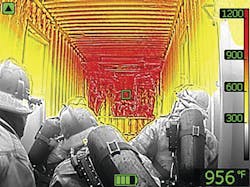Industry Insights: High Temperature Ranges in TICs: Why Higher Isn't Always Better
Editor's note: Industry Insights are sponsored blogs submitted by manufacturers and suppliers serving the fire service industry.
Thermal imaging cameras, or TICs, can be lifesavers for fire crews. Not only can they help firefighters find their way through smoky dark buildings, TICs can also help them pinpoint the seat of the fire so they can swiftly and efficiently douse the flames. And because TICs can visualize heat, they’re a vital tool for search and rescue, hazmat operations, and more.
Choosing the right thermal camera model can be tricky. It’s often a complex exercise of spec comparison, including image resolution, camera sensitivity, and temperature range. Firefighters sometimes go after a TIC that can display the largest temperature ranges. This is not necessarily a good idea. In fact, there are very good reasons why some thermal imaging cameras only measure up to 1,200 degrees.
Temperature range indicates the minimum and maximum temperatures that a camera can measure. As an example, FLIR’s K-Series cameras accurately measure temperatures between -4 to 1202°F. Other brands will measure maximum temperatures above 2000°F, tempting the unwary buyer into a story of ‘more is better’. Although these numbers might seem spectacular to an equipment buyer, in today’s state-of-the-art thermal imaging technology, high temperatures come at the expense of image quality. And for a firefighter, image quality can make the difference between life and death.
Here is what you should keep in mind about high temperature ranges in TICs:
1. Dangerous loss of image quality
The term ‘temperature range’ is a bit misleading. What is more important for a firefighter is the Effective Temperature Range (ETR), which measures the range of temperatures that a TIC can view while still providing useful information to the user. Specifically, extreme heat in the field of view tends to inhibit a TIC’s ability to discern surfaces having intermediate temperatures and details. This loss in image quality and reduction in contrast can have severe consequences for a firefighter, because there’s a chance of missing objects that are located in the lower temperature range, such as victims or escape routes. Firefighting cameras usually have a high- sensitivity and a low-sensitivity mode. In absence of a fire, the TIC will operate in high-sensitivity mode, presenting the thermal environment in all its detail. In case of a fire incident, the camera will switch to low-sensitivity mode, which offers a well-balanced and acceptable trade-off between lower sensitivity (less detail) and the ability to monitor higher surface temperatures. For FLIR’s K-Series cameras, low-sensitivity mode measures temperatures up to 1202°F. Measuring even higher temperatures would mean shifting to an even lower-sensitivity mode (third gain mode), where higher temperatures can be measured at the expense of image detail and contrast, leading to unacceptable image quality loss. A third gain mode might prevent firefighters from seeing victims, colleagues or escape routes, which is a serious safety and rescue issue.
2. The myth of predicting flashovers
Thermal imaging cameras are sometimes believed to be able to predict flashovers. They are not. A flashover will occur at an air temperature that is way beyond 932°F. But even with a TIC that measures in a higher temperature range than 932°F, you will not be able to predict the flashover, because a thermal imaging camera detects differences in surface temperature, not air temperature. There is no black and white answer as to why flashovers occur. Flashovers are hardly predictable and even when the ideal/typical flashover conditions are present, a flashover might not occur. A thermal imaging camera might be useful to identify pre-flashover conditions through reasoned image interpretation. But for now, the only way to be prepared for an imminent flashover is through exhaustive firefighter training, and by carefully observing the environment.
3. Predicting melting steel structures?
Thermal imaging cameras are sometimes said to be able to predict when steel will start to melt and bend. This could especially be useful in firefighting scenes with industrial buildings which often have a steel framework; however, this would still be very difficult. Even with thermal imaging cameras that can measure up to 2,000°F, since the melting point of steel is actually a lot higher (around 2,500°F), you would not get an accurate temperature. Will my FLIR TIC survive higher temperatures? FLIR K-Series cameras do not present temperature differences beyond 1202°F. Instead, red colorization is used to warn the firefighter about present danger. In this case, the FLIR TIC will simply indicate ‘>1202°F’ in the display while staying in the well-balanced low-sensitivity mode, without sacrificing image detailing. K-Series TICs are designed to withstand the toughest firefighting conditions. They can take a 2-meter drop onto a concrete floor, are water resistant (IP67), and remain fully operational up to 500°F for a five-minute duration. The K65 complies fully with the NFPA 1801:2013 standard for firefighting thermal imaging cameras.
- Industry Insights: Aerial Firefighting Technology - Drones and Mountable Thermal Imagers
So when does a high temperature-range make sense? Unlike TICs for firefighting, there are numerous applications where a high temperature reading does make sense. In an industrial and manufacturing environment, FLIR thermal cameras are used to see through flames and to monitor refractory quality of boiler and furnace installations. In some research and development environments, like microelectronics, automotive, plastics, and mechanical testing, high temperature performance is important.
The takeaway? Don’t stress too much about getting the TIC with the highest temperature range and focus on solid image quality
